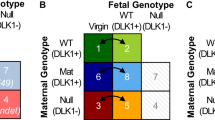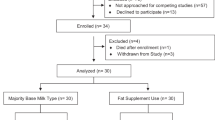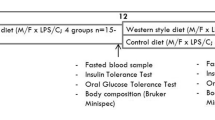Abstract
Background: The n-3 fatty acid status changes during pregnancy and lactation. Plasma leptin concentrations and gene expression have been related to n-3 fatty acids.
Objective: To investigate the relation between plasma leptin concentration and the docosahexaenoic acid (22:6n-3) content of plasma phospholipids during early pregnancy and the postpartum period.
Design: Leptin (radioimmunoassay) and the phospholipid fatty acid profile (capillary gas-liquid chromatography) were measured in plasma of women during two independent longitudinal observational studies. Dietary intake of n-3 fatty acids was also determined.
Results: Within the first 10 weeks after the last menstrual period, an almost parallel increase in leptin concentration and the 22:6n-3 content (mg/l and % wt/wt) of plasma phospholipids was seen (study 1, n=21). During the postpartum period (study 2, n=57), leptin levels decreased quickly, preceding the changes in 22:6n-3 concentrations. During both studies, leptin concentrations did not consistently relate to dietary intake of n-3 fatty acids or to 22:6n-3 concentrations in plasma phospholipids. Before and during early pregnancy (study 1), significant positive associations between leptin levels and the total amount of phospholipid-associated fatty acids were found. No such association was seen during late pregnancy or the postpartum period (study 2). The postpartum decrease in leptin levels did not differ between lactating and non-lactating women.
Conclusions: Not the 22:6n-3 content, but the total amount of phospholipid-associated fatty acids was related to plasma leptin concentration, before and during early pregnancy but not during late pregnancy and the postpartum period.
Sponsorship: Dutch Organization for Scientific Research (NWO, grant no. 904 62 186).
European Journal of Clinical Nutrition (2001) 55, 244–251
This is a preview of subscription content, access via your institution
Access options
Subscribe to this journal
Receive 12 print issues and online access
$259.00 per year
only $21.58 per issue
Buy this article
- Purchase on SpringerLink
- Instant access to full article PDF
Prices may be subject to local taxes which are calculated during checkout
Similar content being viewed by others
Author information
Authors and Affiliations
Contributions
Guarantor: P Rump.
Contributors: PR contributed to the design, was responsible for data analysis and wrote the manuscript. SJO was responsible for study design, subject recruitment, fieldwork and assisted in the writing of the manuscript. GH supervised the project, contributed to study design and assisted in the writing of the manuscript.
Corresponding author
Rights and permissions
About this article
Cite this article
Rump, P., Otto, S. & Hornstra, G. Leptin and phospholipid-esterified docosahexaenoic acid concentrations in plasma of women: observations during pregnancy and lactation. Eur J Clin Nutr 55, 244–251 (2001). https://doi.org/10.1038/sj.ejcn.1601151
Received:
Revised:
Accepted:
Published:
Issue date:
DOI: https://doi.org/10.1038/sj.ejcn.1601151
Keywords
This article is cited by
-
Elevated Production of Docosahexaenoic Acid in Females: Potential Molecular Mechanisms
Lipids (2010)
-
Does the first pregnancy precipitate age-related fat deposition?
International Journal of Obesity (2002)



